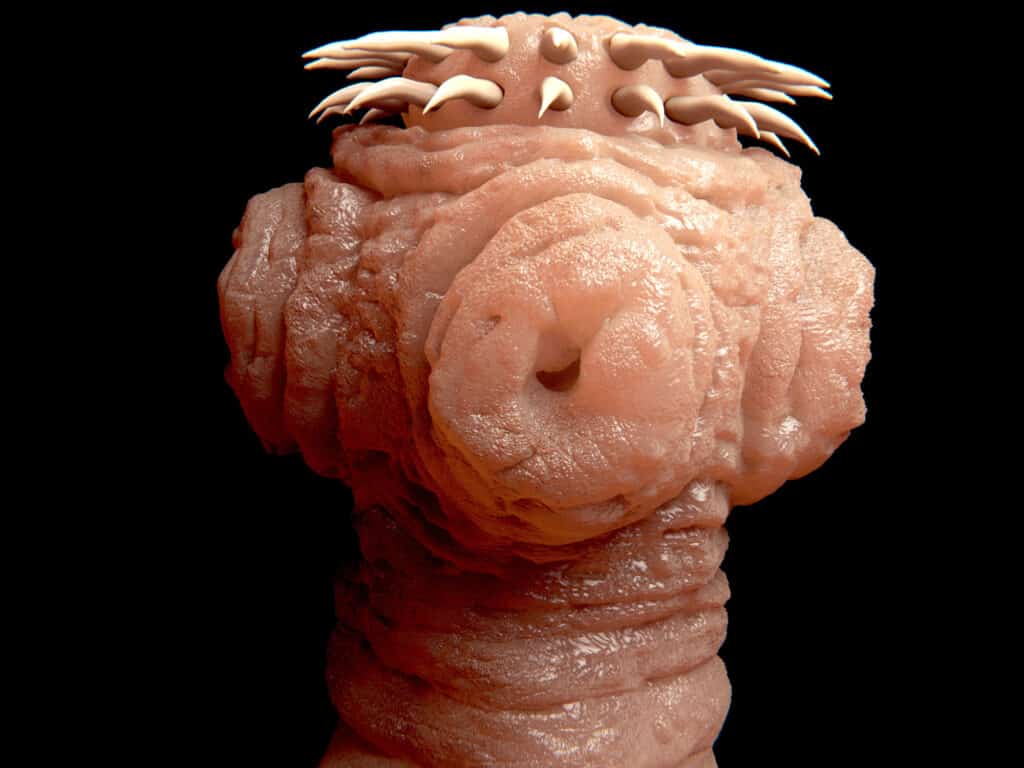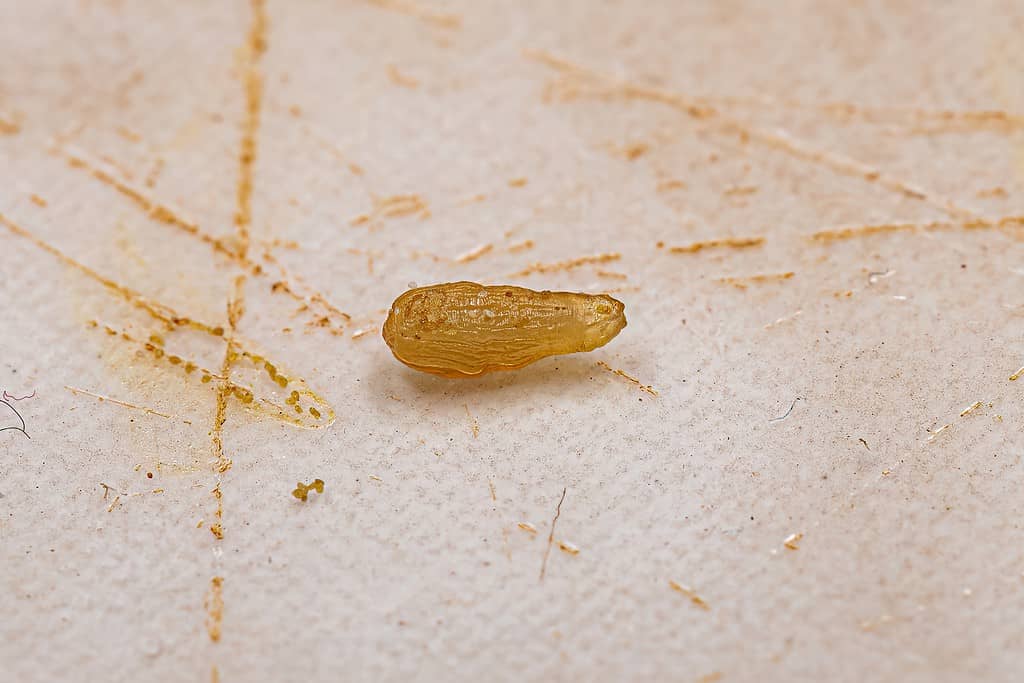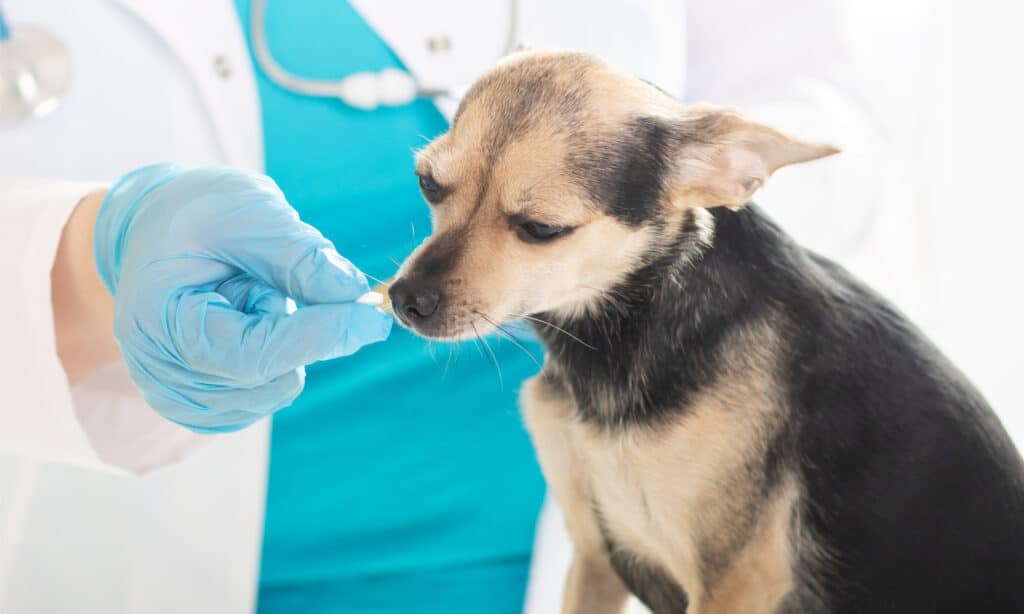Dogs are not just our pets — they are an important part of our families! So, as responsible pet owners and guardians, we want to make sure our beloved canines live happy and healthy lives. Unfortunately, however, one of the things that can hurt your dog is the dreaded tapeworm — those wriggling, writhing intestinal parasites that can make even the strongest stomach turn.
These nasty little parasites can make your dog sick and extremely uncomfortable. If they are left untreated, they can lead to serious health complications like weight loss, vomiting, and even damage to your dog’s organs. Luckily, finding and removing tapeworms in dogs is simple and easy. So, let’s jump right in and explore a list of effective techniques to help you find and remove tapeworms from your pup!
What Are Tapeworms?

Tapeworms are intestinal parasites that live inside the small intestines of host animals.
©iStock.com/
Growing up to 11 inches long, tapeworms are intestinal parasites that live inside the small intestines of host animals. As they grow and mature, tapeworms shed individual segments of their bodies — called proglottids — which eventually make their way out into the world via their host’s feces. Unlike their impressively large main body, these small segments are only about the size of a grain of rice!
These wiggly little parasites plague not just dogs and cats, but many different types of animals — including humans. Although just a glimpse of these vampiric creatures can make you shudder, it is crucial to understand how they work, so you can keep an eye out for any signs of them. Timely treatment is vital to prevent these worms from wreaking havoc on your dog’s body.
However, before you get too worried, you should know that tapeworms typically are not super harmful to dogs, especially if they are treated right away. Tapeworms typically can cause irritation, stomach pain, and diarrhea. However, if they become lodged in other parts of your dog’s body, they can cause serious diseases and damage. Tapeworms can be especially dangerous to puppies, as they can cause internal blockages, anemia, and stunted growth.
How Do Dogs Get Tapeworms?

Adult tapeworms will break off into segments roughly the size of a grain of rice that exit the dog’s body through their feces.
©Vinicius R. Souza/Shutterstock.com
The most common type of tapeworm that your dog can get is Dipylidium caninum. Fortunately, dogs can’t get these tapeworms just by being around another infected animal or from eating tapeworm eggs. These pesky parasites require an immediate host to complete their life cycle — usually, a flea.
When an unsuspecting flea larva ingests a tiny tapeworm egg, the egg hatches and matures into an infectious little tapeworm larva within the flea’s body. When your dog is scratching at a flea bite, grooming themselves, or even grooming another animal, they might accidentally swallow the little flea — along with the growing tapeworm larva. Once the flea enters your dog’s small intestine, the tapeworm larva is released and anchors itself to the dog’s intestinal lining. Here, it feeds off of the dog’s nutrients as it continues to grow into an adult tapeworm.
As they get bigger, these sneaky parasites start breaking off into segments, which eventually make their way out of your dog’s body through their feces. These segments — called proglottids — have white, wriggling bodies that are about the size of a grain of rice. But here’s where it gets even more disgusting: each tiny segment contains a cluster of tapeworm eggs that are ready to be gobbled up by a new host (such as another unsuspecting dog) and start the cycle all over again. It’s a never-ending nightmare that every responsible dog owner wants to avoid!
Less Common Types of Tapeworms in Dogs
In addition to Dipylidium caninum, there are a few less common types of tapeworms that your dog could get. Taenia tapeworms, for example, use small creatures like mice, birds, and rabbits as their intermediate hosts. Unfortunately, this puts dogs who love to hunt and explore at risk. If your pup happens to catch and devour one of these infected animals, they could end up with a Taenia tapeworm too.
Another troublemaker, Echinococcus, primarily lives in coyotes and foxes, but it can sometimes spread to rodents. If your dog happens to hunt and snack on an infected rodent like a mouse, squirrel, or even a rabbit, they could also become infected with an echinococcosis tapeworm.
How to Find and Remove Tapeworms in Dogs
Fortunately, there are ways to find and remove tapeworms in dogs before the infestation gets worse. One of the easiest and most effective ways to find tapeworms in dogs is by closely examining your dog’s feces. It may seem gross, but this really is the quickest way to know whether you’re not your dog has tapeworms.
As tapeworm segments break off inside the small intestine, they will pass out of your dog’s body in their feces. These little tapeworm segments are small and white — and often wriggling — they basically look like little moving grains of rice. You might also spot them in the hair around your dog’s anus, or occasionally when your dog throws up. Sometimes dried tapeworm segments also show up in your dog’s bed. They are usually more yellow or golden in color, rather than white.
However, just because you do not see tapeworms doesn’t mean that they aren’t currently living inside your dog’s body. In addition to watching for tapeworm segments, it is also very important to keep an eye out for any other potential signs of tapeworms in your dog. Here are some of the symptoms to watch out for.
Signs and Symptoms of Tapeworms in Dogs
- Tapeworm segments in your dog’s feces, around their anus, in their bed, or in their vomit.
- Fatigue and lethargy
- A dull coat
- Diarrhea
- Vomiting
- A distended abdomen
- Weight loss, even when your dog seems to be eating normally.
- A dog scooting their rear end along the floor or another rough surface.
- A dog who is trying to chew or bite at their rear end.
You should take your dog to the veterinarian regularly. This also helps catch tapeworms early and prevent them from causing serious harm to your dog. The vet can also do a fecal test, which sometimes detects tapeworm eggs that are not visible to the naked eye.
How to Remove Tapeworms in Dogs

The most effective tapeworm treatments for your dog can be prescribed by your veterinarian.
©iStock.com/Yana Tikhonova
Don’t panic just yet, because thankfully, removing tapeworms in dogs is simple and easy. The most effective tapeworm treatments can be prescribed by your veterinarian. Praziquantel, for example, is a prescription medication that can be taken orally, topically, or through injection. It works by dissolving the tapeworm within your dog’s intestine and has very minimal to no side effects.
There are also a wide variety of other medications that your vet can give you to remove tapeworms in your dog’s gut. There are handy chewables as well as granules that you can sprinkle on your pet’s food. In addition, there are even combination parasite medications available. These can tackle not just tapeworms, but also roundworms, whipworms, and hookworms all at once.
It is vital that you the prescribed dosage and complete the entire course of prescribed medication. In other words, be sure to give your dog all of the medication until it is gone — even if your dog seems to already be on the road to recovery. Tapeworm, medication does not just treat the symptoms of an infestation; it also eradicates the root cause. By ensuring your pup takes all of their prescribed medication, you can rest easy knowing that every last tapeworm has been eliminated from their system.
Preventing Tapeworms in Dogs
While tapeworm medications are highly effective, your dog may begin to show signs of another tapeworm infestation a few weeks after their initial recovery. However, this is not because the medicine didn’t work — repeated infections are almost always caused by a new flea infestation.
To ensure your dog stays healthy and tapeworm free, you’ll need to protect them from fleas in their environment. Your veterinarian can recommend safe and effective flea control options to protect your dog from both fleas and tapeworms. Keeping fleas under control is crucial when it comes to managing and preventing tapeworm infections in your dog. If your dog lives in an environment infested with fleas, they are at risk of getting tapeworms again in as little as just two weeks! So, if your dog gets tapeworms, be sure to treat both your dog and their environment.
Can You Get Tapeworms From Your Dog?
Although the risk is very low, yes — it is possible to get tapeworms from your dog. However, in order for Dipylidium tapeworms to pass from your dog to your own body, they need a host — like a flea. In other words, the only way to get these tapeworms from your dog is if you accidentally swallow a flea that is infected.
Echinococcosis: A Tapeworm You Don’t Want to Mess With
Although many tapeworms in dogs don’t pose much risk to humans, echinococcosis tapeworms have been causing some serious problems lately. Echinococcosis mostly lives in foxes and coyotes. However, it can spread to rodents as well — which is a big problem for hunting dogs that like to chase and eat squirrels, mice, or rabbits. Although you don’t want your dog picking up any type of tapeworm, you especially want them to avoid echinococcosis.
Fortunately, echinococcosis does not typically cause issues for dogs — but unfortunately, it does for humans. These tapeworms have especially small segments, so they can be hard to spot and find in dogs. They shed their eggs into your dog’s feces. If you accidentally ingest one of these eggs, it can make you super sick. In some cases, it can even be fatal. These nasty tapeworms wreak havoc on the lungs and liver of their human hosts. They cause large, ominous cysts to form within these vital organs.
That’s why it is so important to deworm your dog at least once a month to prevent any type of tapeworm from taking residence in their gut. In addition, be sure that you bag any feces that they leave behind and throw them in the trash anytime you take your dog to the park or other public places. And of course, always thoroughly wash your hands anytime you have to handle your dog feces.
Unfortunately, children are the most susceptible to this type of infection because they’re often the ones playing outside in grassy areas and parks where dogs may have left their waste behind. So, if you have kids who love to play outdoors, it’s important to keep a close eye on their hygiene and make sure they wash their hands thoroughly after playing with their furry friends.
The photo featured at the top of this post is © iStock.com/shironosov
Ready to discover the top 10 cutest dog breeds in the entire world?
How about the fastest dogs, the largest dogs and those that are -- quite frankly -- just the kindest dogs on the planet? Each day, AZ Animals sends out lists just like this to our thousands of email subscribers. And the best part? It's FREE. Join today by entering your email below.
Thank you for reading! Have some feedback for us? Contact the AZ Animals editorial team.






